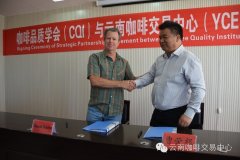The output of coffee beans in Yunnan reached 139000 tons at the end of the harvest season from 2015 to 2016.
A few days ago, the reporter learned from the Yunnan Coffee Industry Association that the province's coffee harvest season from 2015 to 2016 is over. Preliminary statistics show that the province's coffee output reached 139000 tons, an increase of 21000 tons over the 2014-2015 harvest season of 118000 tons.

"although the output of 139000 tons has increased compared with the previous picking season, it has still shrunk by about 20, 000 tons than expected due to the disaster of low temperature and cold wave, low market prices and other factors." Li Gongqin, secretary general of the provincial coffee industry association, said that at the beginning of this year, precipitation and cooling weather occurred on a large scale in the province. Although the early warning was timely, it still brought great losses to the coffee, tea and other industries. As far as the coffee industry is concerned, Pu'er, Lincang and Wenshan are seriously affected, while Dehong and Baoshan are relatively good.
Compared with the low temperature and cold wave disaster, the impact of the market downturn can not be ignored. Li Gongqin told reporters that in the 2015-2016 harvest season, the average price of coffee beans purchased by enterprises from curry farmers was between 13 and 14 yuan, and the market trade price was maintained at about 16 yuan. the depressed market situation led to the low enthusiasm of enterprises or farmers for picking. In Honghe, Baoshan and other places, there is still a phenomenon of abandoning harvesting and management, which also brings certain losses to coffee production in the province.
Hu Lu, vice president of the provincial coffee industry association, said that although the output of this harvest season was lower than expected and the market was relatively depressed, the prospect of Yunnan coffee was still promising. "judging from the current public information, both Pu'er and Lincang plan to stabilize the coffee planting area at about 1 million mu. According to this calculation, the province's coffee planting area will reach 2.8 million mu by 2020, and the province's coffee will enter a high-yield period. coffee output is expected to reach 18-200000 tons at that time, when Yunnan's important position in the main coffee producing areas in the world will be further enhanced."
The huge consumption potential of China's coffee market obviously gives Yunnan coffee industry great confidence. Figures show that at present, the per capita coffee consumption in China is only 4 cups, and even in Beijing and Shanghai, the per capita annual consumption is only 20 cups, which is far lower than 40 cups in Taiwan, 240 cups in South Korea and 200 cups in Japan. compared with the level of about 400 cups in the United States and other European countries, the coffee consumption market has great potential in the future. "as far as the domestic market is concerned, even if the planting area of Yunnan coffee reaches more than 2.8 million mu, in front of the rapidly growing market, it will still be in short supply." Hu Lu said.
However, Li Gongqin still called on government departments to continue to increase support for the coffee industry. "when the market remains in the doldrums, it is difficult to rely on enterprises or the market to ensure the entrepreneurial nature of coffee farmers, which will eventually have a negative impact on the healthy development of Yunnan coffee industry, and the relevant departments should increase policy and financial support. starting with planting and processing, we should improve the overall quality of coffee in Yunnan and effectively safeguard the interests of farmers." Li Gongqin said. (chief reporter Yin Lei)
Important Notice :
前街咖啡 FrontStreet Coffee has moved to new addredd:
FrontStreet Coffee Address: 315,Donghua East Road,GuangZhou
Tel:020 38364473
- Prev

Coffee maker New Technology Coffee alarm clock Coffee creativity of London Product designer
The Barisieur, designed by London-based product designer Josh Renouf, is an alarm clock with its own coffee-making function, designed to promote better sleep and, of course, to give you a better morning. You can set the alarm clock before you go to bed, put your favorite coffee into the Barisieur, add milk and sugar, and you can do it the next morning.
- Next

Coffee quality Society (CQI) and Yunnan Coffee Trading Center (YCE) formally signed a strategic cooperation agreement
At the invitation of Yunnan Coffee Trading Center Co., Ltd., Mr. DavidRoche, Executive Director of CQI (Coffee Quality Institute, Coffee quality Society), arrived in Pu'er on the morning of November 7, 2015 with Lu Han, Deputy Director of Tea and Coffee Industry Bureau, Cao Ronggen, Chairman of Yunnan Coffee Trading Center, and Shu Yang, Executive Deputy General Manager, on the development of Yunnan Pu'er boutique coffee.
Related
- A complete list of coffee bean names and their meanings! What is Yejia Shefi coffee? Where is Mantelin coffee?
- What grade does Arida Manor Kaduai coffee beans belong to? What treatment is Arida ASD slow anaerobic sun exposure?
- The milk tea cup becomes smaller?! Overlord Tea Girl launches a new "Return to Yunnan" series
- Accused of selling counterfeit and high-priced coffee beans! Well-known boutique coffee brand "Oukelao" bowed and apologized!
- How to make espresso dumplings? Can I eat coffee and glutinous rice balls together?
- Save the unformed and stagnant powder cakes in one second! What is the problem with stagnant water in the powder bowl of the espresso machine?
- What does hand-brewed coffee stop mean? Why is it not recommended to make coffee by hand?
- Is it normal to smell like coffee? Why does coffee smell like alcohol? What's wrong with the strong smell of cold extract ice dripping ice brewed coffee?
- How to solve the problem that hand-brewed coffee extraction takes too long? Why is the water flowing so slowly when making coffee?
- The main points of making Australian white coffee, the proportion details, how does Australian white properly foam and blend the flowers?

